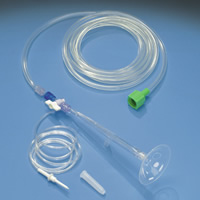“With the introduction of Jetox™ into our clinic, we are now able to debride 5 patients on a weekly basis whom previously did not tolerate sharp debridement. What a godsend! I can tell you that patients are grateful for having found a modality which allows appropriate debridement with much reduced (or no) pain.” Harvey Hashimoto MD, Medical Director, Lodi Health Wound Treatment Center, Lodi, CA

Have you treated or cared for a patient who could not tolerate sharp
debridement due to pain intolerance? Or, have you found that the next
step for a patient was to take them to the operating room to remove the
devitalized tissues present on their wound bed? After almost a decade
of being involved with wound care treatments, I know that this situation
is very prevalent.
“With the introduction of Jetox™
into our clinic, we are now able to debride 5 patients on a weekly basis
whom previously did not tolerate sharp debridement. What a godsend! I
can tell you that patients are grateful for having found a modality
which allows appropriate debridement with much reduced (or no) pain.” Harvey Hashimoto MD, Medical Director, Lodi Health Wound Treatment Center, Lodi, CA
As
many know, debridement is an appropriate treatment to transition a
chronic wound to resemble an acute wound by improving the protease and
cytokine levels. If a wound has necrotic tissues present, it is not
considered a healthy wound bed, which can increase healing times for the
patient. With sharp or surgical debridement being the quickest and
most effective option for debridement, many patients have pain at their
wound bed and cannot tolerate this option of debridement. As a
clinician, we want these wounds to have the best chance at healing as
quickly as possible. The less time it takes to heal, the less chance
the wound has to get infected or cause further issues for the patient.
Other options for debridement include autolytic, mechanical,
enzymatic/chemical, and bio-surgical. I have listed some of the
features of each type of debridement along with potential downfalls from
each of these:
- Autolytic debridement is the destruction of
necrotic tissues that use the body’s white blood cells and natural
enzymes to digest the devitalized tissues while leaving healthy tissues
intact. This can be a very slow process, as some patients do not have a
sufficient amount of white blood cells to complete this process. While
this is the least invasive method of debridement, it can also be the
slowest.
- Mechanical debridement is a non-selective form of
debridement. Force is used to manually remove a dressing with hopes that
the necrotic, or non-viable, tissues are removed along with the
dressing. This form of debridement can be very painful and, since it is
non-selective, the chance of removing healthy tissues along with the
non-viable tissues is high.
- Enzymatic/Chemical debridement
products dissolve necrotic tissues. Currently, there are only 1-2
products in the wound care market that meet standards for enzymatic
debridement. From my experience, these products can also take a long
time to reach the treatment goal, often requiring sharp debridement in
conjunction. Another negative is that these products can be very
expensive and many times are not covered by insurance.
- Bio-surgical
is the medical use of live maggots (fly larvae) for treating
non-healing wounds. Medicinal maggots have three mechanisms of action,
1) they debride (clean) wounds by dissolving the dead (necrotic),
infected tissue; 2) they disinfect the wound by killing bacteria; and 3)
they stimulate wound healing. This process can be time consuming as
well as not widely accepted by patients. Although it is an effective
debridement tool, it is not widely utilized due to regulatory
restrictions in many places.
Jetox™,
a high powered jet lavage treatment from DeRoyal, allows for a
debridement option that is effective in removing devitalized tissues
without the use of extra tools or products. Your treatment options
after debridement can vary based on the needs of your patient; however
Jetox™ gives you a debridement option that is quick, with little to no
mess and has been reported by patients to be virtually painless. Jetox™
is effective in removing unwanted necrotic tissues which helps stimulate
the wound bed for healing purposes. This product does not require or
need suction due to the minimal amount of fluid necessary to get the
desired results and has been assigned a CPT code that may be
appropriately billed in many settings.
Jetox™ is ideal for use on
patients who cannot tolerate sharp debridement. It can also be used in
conjunction with other therapies for debridement (e.g. primary dressing
choices). Clinicians have mentioned how easy Jetox™ is to set up and
use, but more importantly they and their patients have been very
impressed by the results they are seeing with their wounds!
© 2014 DeRoyal Industries, Inc. All Rights Reserved. Jetox™ is used under license by DeRoyal.

Theresa Alvarez, RN, BSN, CWOCN
Theresa is the global wound care clinical specialist for DeRoyal.
Her primary roles are to provide evidence and knowledge based support
for the DeRoyal advanced wound care, burn care, and negative pressure
wound therapy product lines. She is a clinical support for our sales
teams and customers with assisting with product training, trials,
implementations, and general assistance when requested.